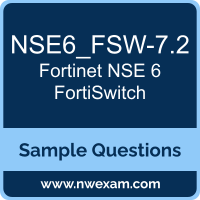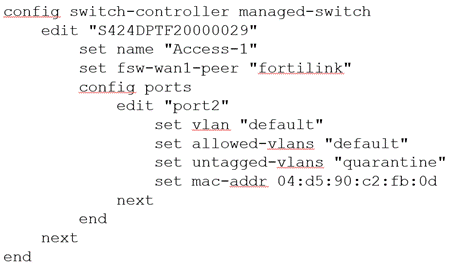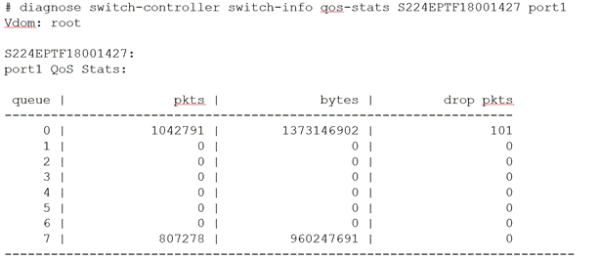01. Some FortiSwitch models are equipped with two management interfaces. Which two statements about these two FortiSwitch management interfaces are true?
(Choose two.)
a) One interface is an out-of-band interface and the other is an in-band interface.
b) The dedicated management interface is only one physical port.
c) Both management interfaces can be configured with the same native VLAN.
d) FortiLink tunnel can be used on both management interfaces.
02. View the exhibit.
You need to display the current physical topology of the two-switch stack managed by FortiGate using a graphical editor. However, the editor cannot accept the output shown in the exhibit. Which two reasons prevent you from creating the physical topology design?
(Choose two.)
a) Physical topologies can be displayed only on the FortiGate GUI.
b) The topology cannot be created due to incomplete data.
c) Graphical editors support only grapyiz format data.
d) The CLI output must be in dot format.
03. What happens if a FortiSwitch port is configured with a security profile which has EAP pass-through enabled, but the authentication server does not support EAP?
a) All devices will be placed on the authentication fail VLAN.
b) EAP messages will be processed by FortiSwitch, if the authentication server is incompatible.
c) The authentication server will relay EAP messages to a compatible server.
d) The security profile will perform a test to confirm server compatibility.
04. Which statements about using the FortiLink split interface when selecting FortiLink interface members are true?
a) FortiLink must be configured on a software-switch interface.
b) The FortiLink trunk on a managed FortiSwitch must be configured with an MCLAG active-passive setup.
c) FortiGate can keep only one FortiLink interface member active at a time.
d) The FortiLink interface is directly connected to more than one FortiSwitch.
05. At which layer in the hierarchy network model is the high speed factor crucial, when selecting an appropriate FortiSwitch device?
a) Core layer
b) Distribution layer
c) Access layer
d) Edge layer
06. You are asked to convert from using FortiGate to manage FortiSwitch to using FortiLAN Cloud instead. However, you are unable to log in to FortiLAN Cloud. Which two reasons explain the failure to register and manage FortiSwitch using FortiLAN Cloud?
(Choose two.)
a) The FortiSwitch management setting is set to FortiLink.
b) FortiSwitch allows one concurrent administrative access.
c) The support contract associated with FortiSwitch has expired.
d) FortiSwitch uses HTTPS for management traffic.
07. View the exhibit.
FortiGate can quarantine devices connected on all of the managed FortiSwitch ports except port2. Which setting needs to be changed so FortiGate can quarantine devices on port2?
a) Add the quarantine VLAN to the allowed VLAN settings on the port.
b) Add the quarantine VLAN as tagged native VLAN.
c) Enable the quarantine function on the port.
d) Remove the quarantine VLAN from untagged VLANs and assign it to allowed VLANs.
08. For in-depth troubleshooting of packet flow issues on FortiSwitch, which approach is typically recommended?
a) Checking the status LEDs on the device
b) Reviewing virtual LAN configurations
c) Using diagnostic commands to view real-time traffic
d) Resetting the switch to factory defaults
09. How does deploying FortiSwitch in standalone mode differ from managing it over FortiLink?
a) Standalone mode does not allow layer 3 routing configurations.
b) Standalone mode does not integrate with other Fortinet products.
c) Standalone mode allows management via FortiGate only.
d) Standalone mode requires a physical console connection.
10. View the exhibit.
Port1 is assigned the default QoS queue profile. The QoS statistics on port1 are showing dropped packets on the managed FortiSwitch. However, the queue number showing the drops in the output is 0. Which statement explains the reason why queue 0 is the only queue which displays the number of dropped packets?
a) Queue 0 has the highest priority and packets are dropped from it if needed.
b) Queue policy is defined and set to use queue 0 for packets dropped by FortiSwitch.
c) The rate limit set by QoS drops non-critical traffic in the network in queue 0.
d) All traffic except control traffic is assigned to queue 0 as part of the QoS process.
 Before you write the Fortinet NSE 6 FortiSwitch (NSE6_FSW-7.2) certification exam, you may have certain doubts in your mind regarding the pattern of the test, the types of questions asked in it, the difficulty level of the questions and time required to complete the questions. These Fortinet Certified Professional - Network Security (NSE 6 FortiSwitch) sample questions and demo exam help you in removing these doubts and prepare you to take the test.
Before you write the Fortinet NSE 6 FortiSwitch (NSE6_FSW-7.2) certification exam, you may have certain doubts in your mind regarding the pattern of the test, the types of questions asked in it, the difficulty level of the questions and time required to complete the questions. These Fortinet Certified Professional - Network Security (NSE 6 FortiSwitch) sample questions and demo exam help you in removing these doubts and prepare you to take the test.


